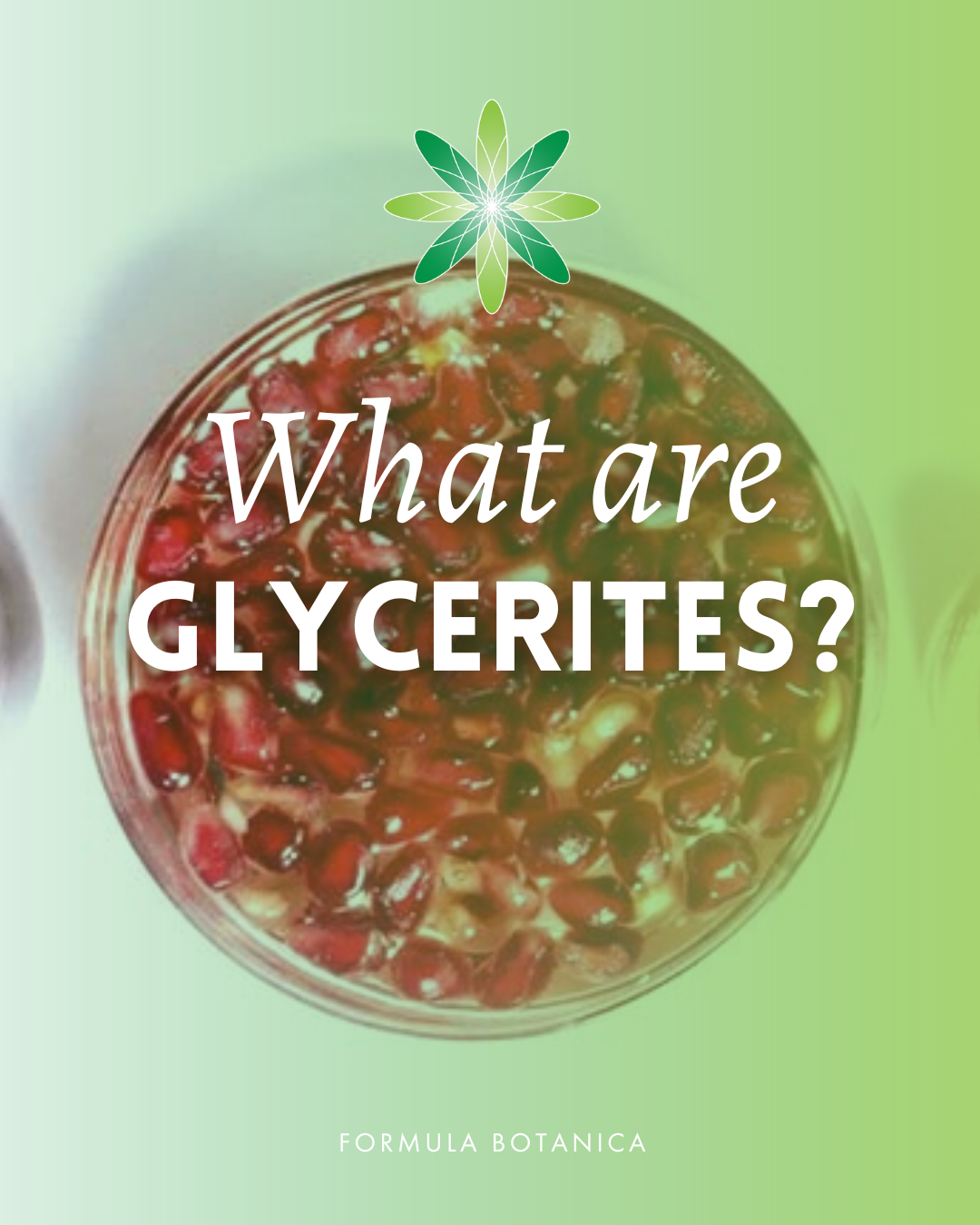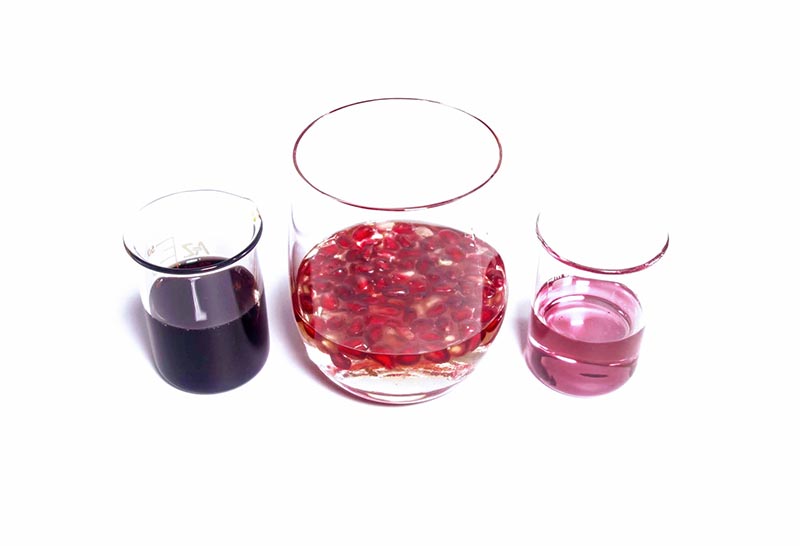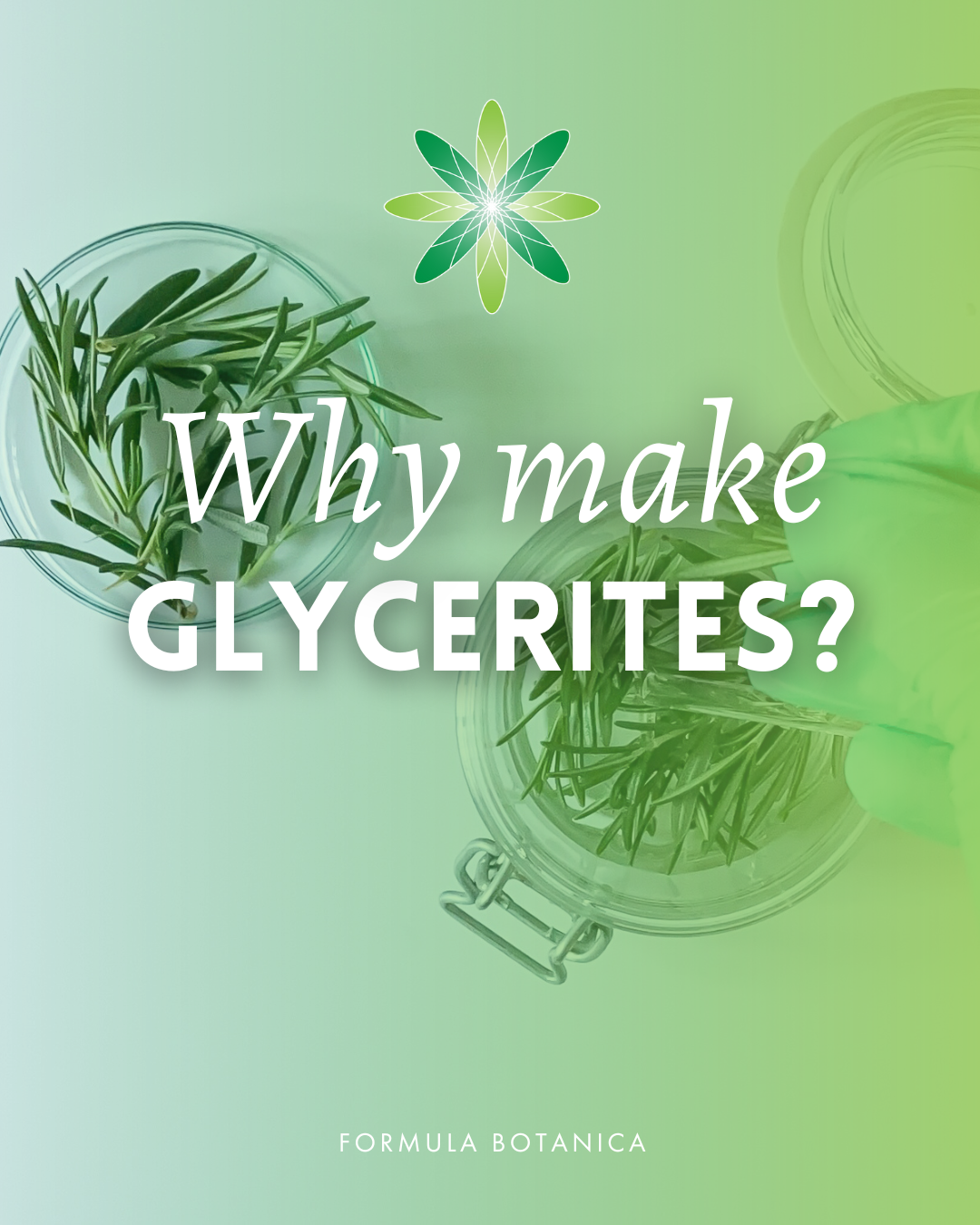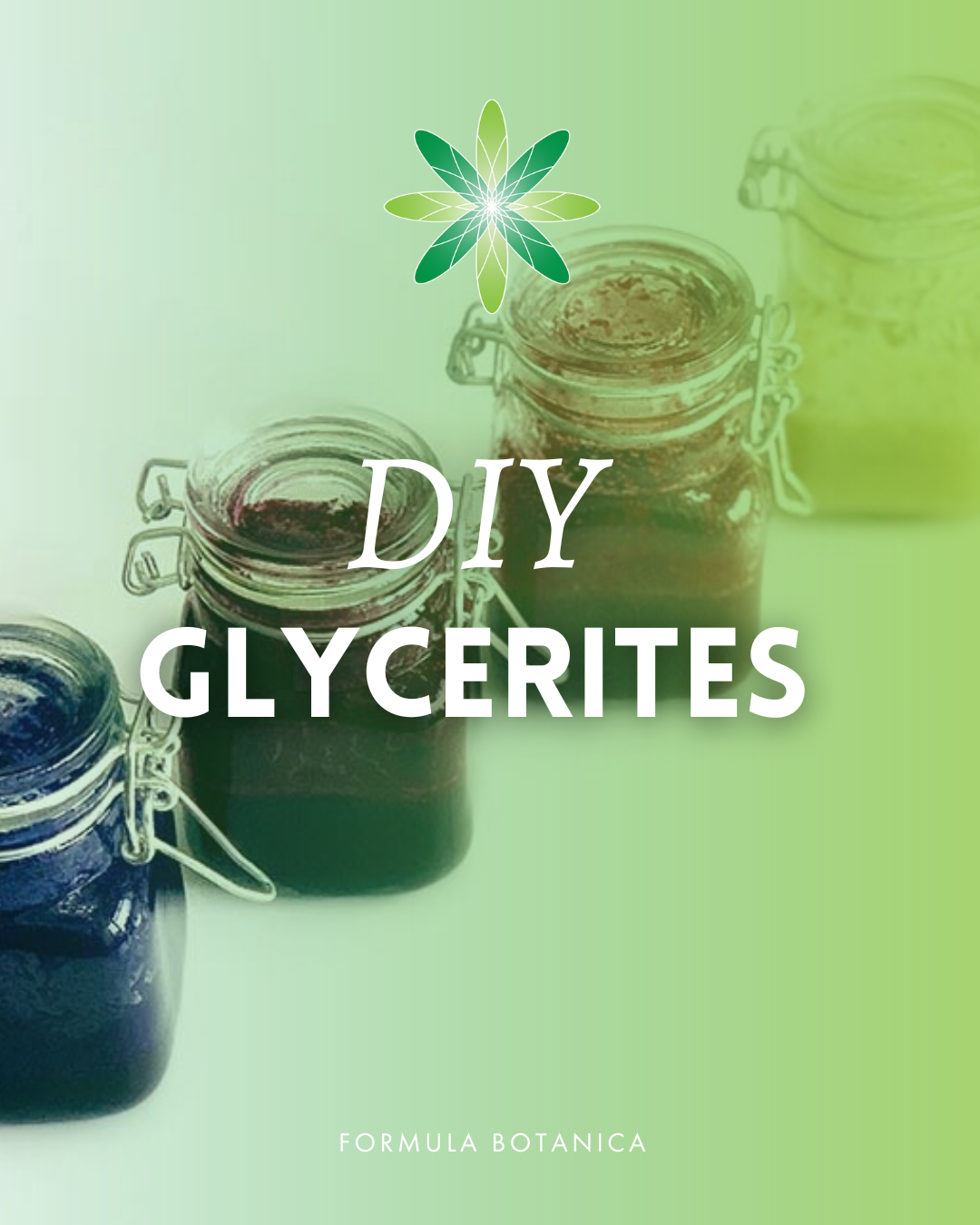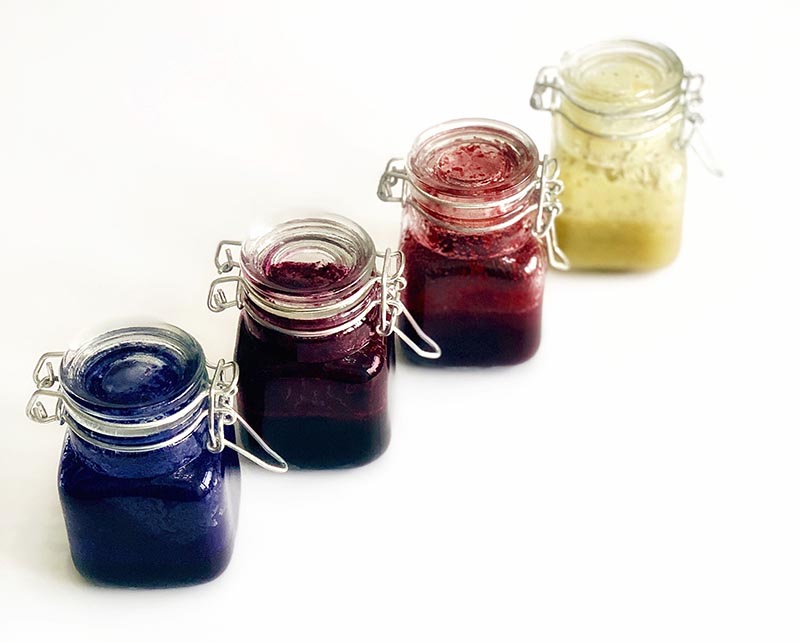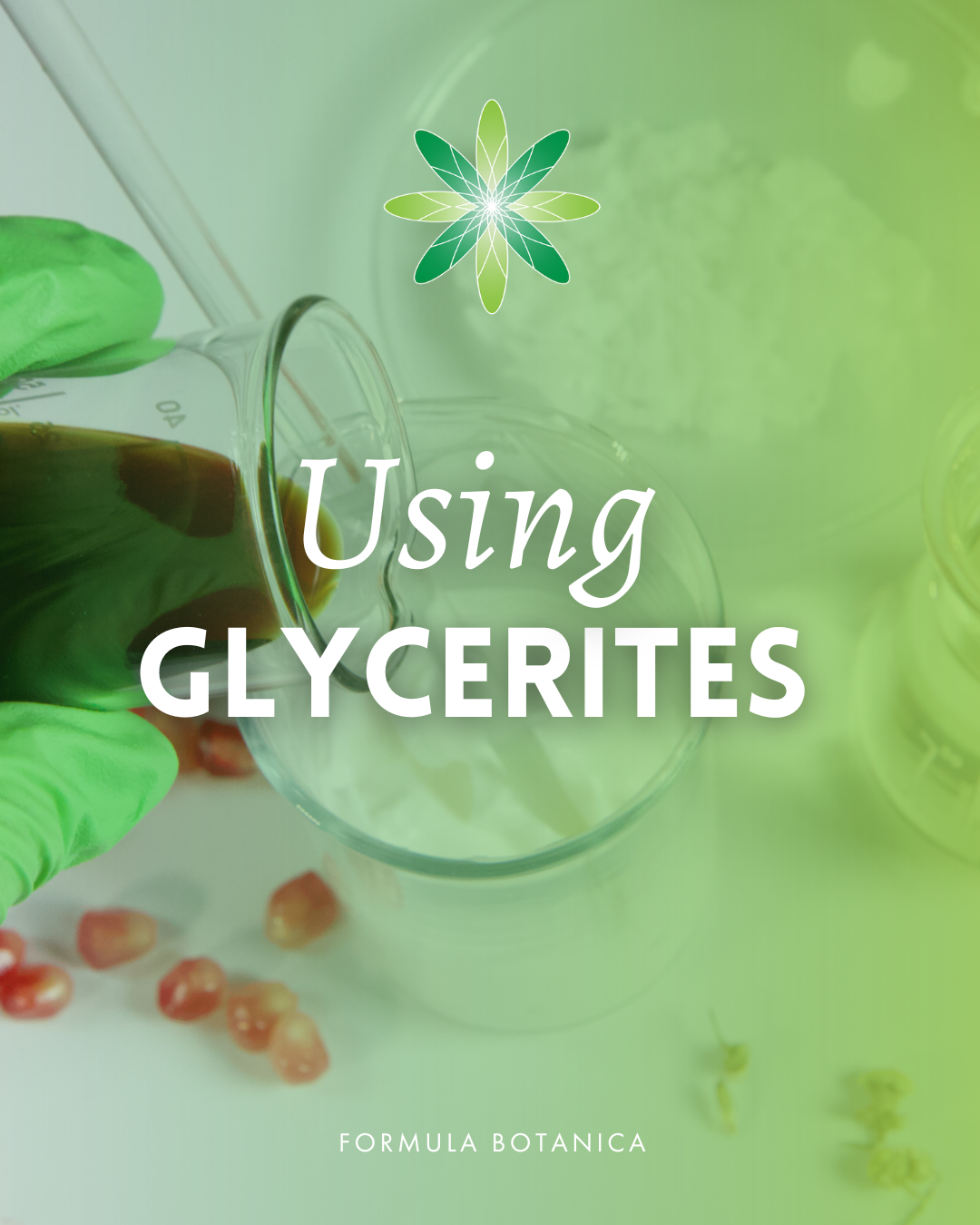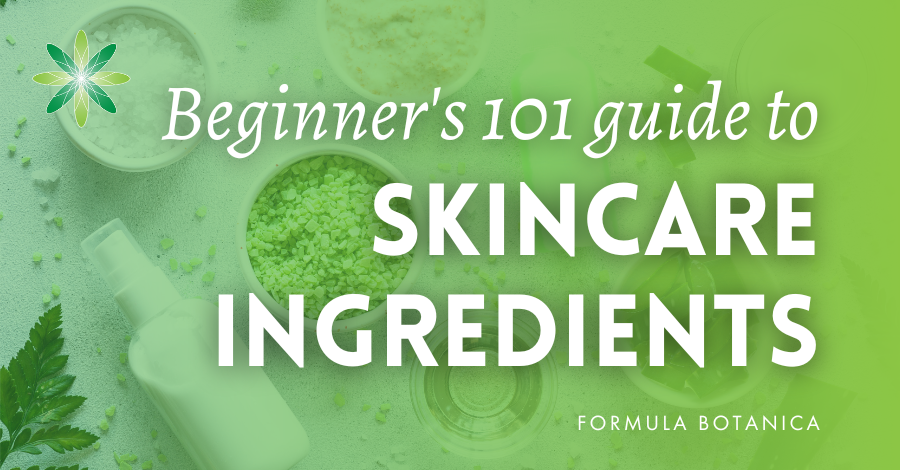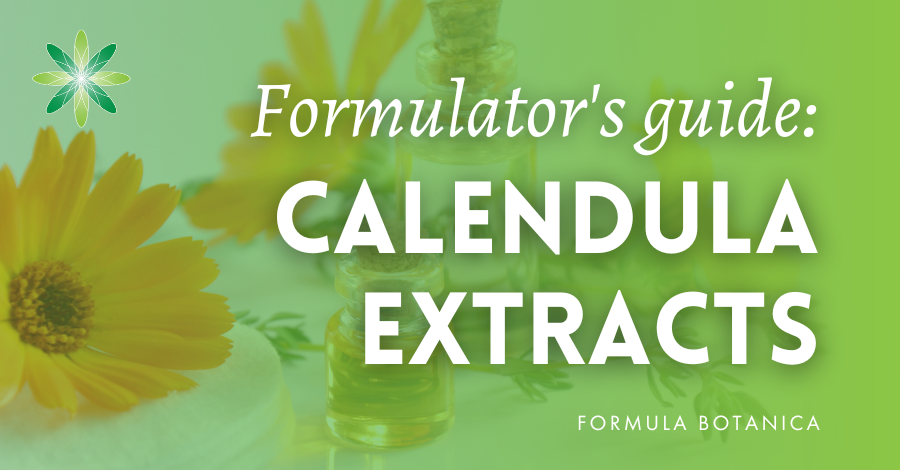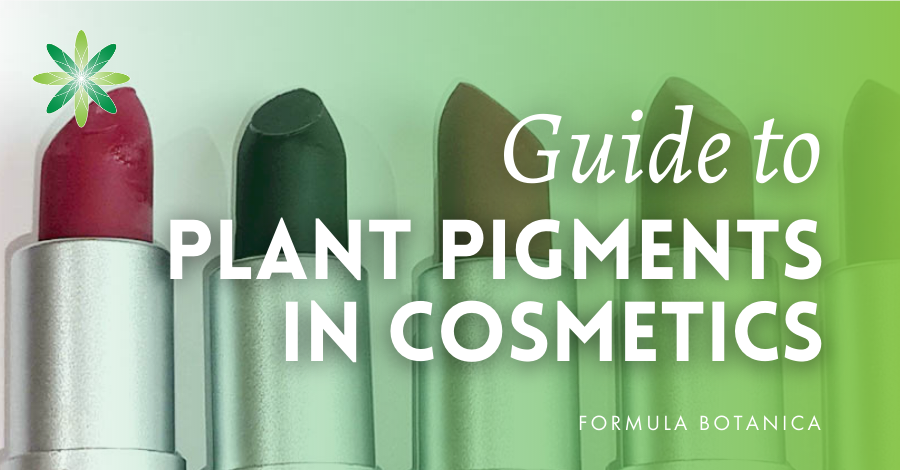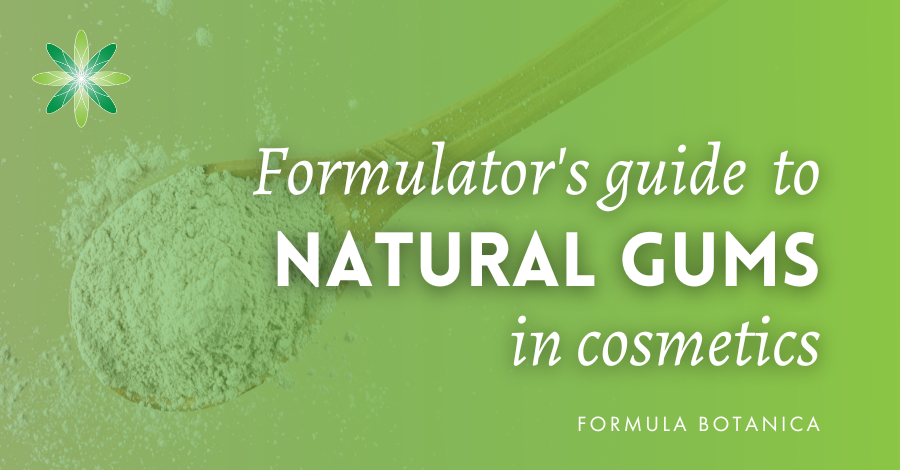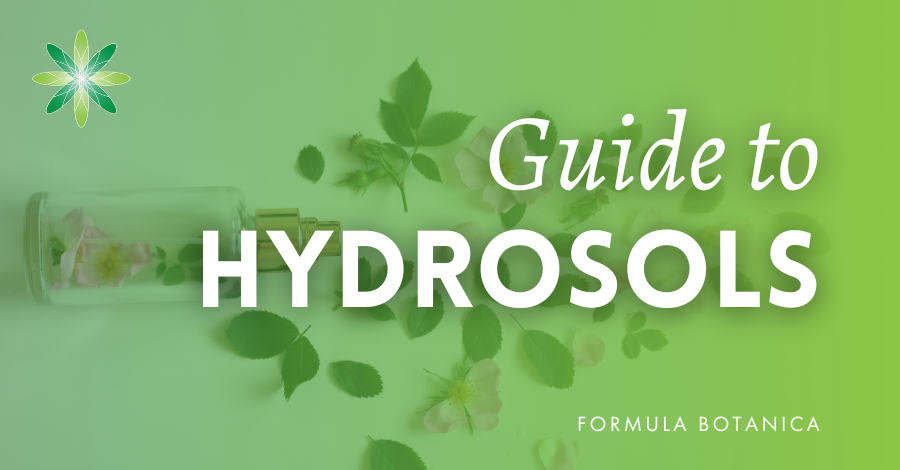Updated: 16.12.25
Imagine this: you open your home lab cupboard and find rows of bottles filled with plant extracts you’ve made yourself – golden chamomile, pink hibiscus, vibrant butterfly pea – all ready to use in your natural formulations. And each one carries the scent, colour, and beneficial properties of the plant you chose. Sounds magical, right?
That’s the power of glycerites: simple, alcohol-free botanical extracts you can make right in your own kitchen or home lab by infusing dried or fresh herbs, flowers, fruits, vegetables, roots, or leaves into glycerine – ready to boost your water-based formulations.
If you’ve ever wanted to make your own plant extracts, this post is for you! By the end of it, you’ll know exactly what glycerites are, how they work, why they’re so beneficial, and, most importantly, how to make them yourself.
What are glycerites?
Let’s start by defining what glycerites are. Glycerites are botanical extracts made by infusing plant material into glycerine (also called glycerol). Essentially, they’re alcohol-free tinctures, which are popular in herbalism and natural skincare formulations.
In herbal extractions, we typically use one of four solvents:
- Water (for infusions and decoctions)
- Oil (for macerated oils)
- Alcohol (for tinctures)
- Glycerine (for glycerites)
In our courses, we teach you how to make macerated oils (which are oil-soluble) and glycerites (which are water-soluble). If you want to learn more about maceration, check out the posts below:
Why use glycerites
What’s so special about glycerites is that they’re water-soluble, meaning you can easily incorporate them into water-based skincare formulations like your toners, serums, creams, and lotions. They also carry the beneficial plant compounds (phytochemicals) into your formulations and can naturally colour or scent your products. What’s not to love?
And there’s a bonus: glycerine is a humectant, meaning it attracts water and helps keep skin soft and moisturised. So, with glycerites, you’re really getting a double benefit.
Does glycerine hydrate the skin?
Some people think that added glycerine will provide hydration to the skin. However, that is technically not true, because hydration literally means giving water. Hydration for your skin can come from the water you drink or the water in a cosmetic product. Dehydrated skin needs hydrating ingredients, like hyaluronic acid or aloe vera.
You can learn more about glycerine and humectants in our formulator’s guide to natural humectants.
Why make glycerites when you can buy them?
As formulators, we typically rely on pre-made extracts that we purchase from suppliers. The advantage of this is that your supplier can provide you with all the necessary documentation about an ingredient, such as Safety Data Sheets (SDS) or Certificates of Analysis (CoA), which you legally need when selling our formulations to the public.
However, if you’re making skincare or haircare products just for yourself, friends, or family, you have the freedom to experiment and create your own extracts at home, with plants that you typically wouldn’t find as extracts.
Making your own glycerites is also a wonderful way to connect with nature. It’s hands-on, creative, and a fantastic way to learn how certain plants behave in different formulations. You can even use plants from your own garden!
Below, we’ve included a step-by-step guide for making glycerites for home use. But first, let’s explore the science of how solvents work in extracting phytochemicals, so you understand why glycerites are so effective.
Please note that if you want to sell products containing homemade glycerites, getting the necessary certification and analyses can be costly and time-consuming. In that case, buying professionally prepared glycerites is usually the safer, easier option.
How solvents work in extraction (aka the sciency bit)
When making glycerites (or deciding which to buy), it can be helpful to understand which phytochemicals you want to extract from a plant and why. You may already know the general properties of a plant, but what are the active compounds behind those properties, and in which part of the plant are they found?
If you want to dig deeper, you can research the actives in scientific articles, pharmacognosy books, or databases like PubChem. Finding out which chemical class a compound belongs to can also give you clues about which solvent might be best for extracting it.
With this knowledge, you can make more informed choices about which solvent (water, oil, alcohol, or glycerine) is likely to work best and create (or buy) your own extracts from there!
Don’t worry if this feels overwhelming; understanding all the chemistry is not required to make glycerites at home. This section is just to give you some scientific background so you know why glycerites work the way they do, but you don’t need to be a chemist to make glycerites or use them in your formulations.
For a more detailed look at solvents, check out our guide on choosing the best herbal solvent.
Compounds solvents can extract
Some classes of compounds that can usually be extracted in water and ethanol/glycerine solvents include:
Water
Polysaccharides (e.g., gums and mucilages)
Phenolic compounds (e.g., tannins)
Flavonoids (e.g., anthocyanins)
Aldehydes
Ketones
Amines
Oxygen-containing compounds
Ethanol/glycerine
Sterols
Flavonoids (e.g., anthocyanins)
Terpenoids
Phenolic compounds
Alkaloids
Saponins
Our Formula Botanica students often ask us which is better: oil-based, water-based or glycerine-based. There isn’t a simple answer. It depends on the herb, the solvent, the solubility of the plant’s constituents, and all of the other factors mentioned above – as well as the purpose of your formulation. Glycerites, for example, are great for water-based formulations, but can also be used in low quantities in anhydrous (oil-based) formulations!
How to make your own glycerites, step-by-step
Making your own glycerites is fun, simple, and incredibly empowering. With just a few ingredients and a little patience, you can create effective and alcohol-free botanical extracts to use in your natural skincare or haircare formulations.
What you’ll need
- Plant material: Dried or fresh herbs, flowers, fruits, vegetables, or leaves
- Vegetable glycerine: Cosmetic or pharmaceutical grade
- Distilled or deionised water (optional, only if using dried botanicals)
- Glass jars with lids
- Muslin cloth, fine strainer, or coffee filter
- Sterilised jars for storage
- Labels (for plant name and date)
Here are some ideas of plants you can infuse:
- Fresh food glycerite ideas: Cucumbers, strawberries, blueberries, pomegranate, papaya, red beets, lemons, and more.
- Herb ideas for glycerites: Mallow flowers, calendula, hibiscus, rosebuds, lavender, chamomile, dandelions, elderflowers, ginger, hawthorn – or anything else you love. Feel free to experiment!
You can also experiment with different colours! Check out this article to learn more about how to use plants to infuse natural colour in your formulations.
A quick note before we start:
Earlier, I mentioned that if you plan to sell cosmetic products, it’s usually best to buy glycerites from reputable suppliers because of safety and regulatory requirements. But for home use, making your own glycerites is educational, satisfying, and creative, especially if you love natural ingredients or grow your own plants, like many people in our community.
The guide below is a basic DIY method. There’s plenty more to explore in our courses if you want to take your glycerite-making further!
Step-by-step guide to making your own glycerites
Here’s how to make your own glycerites in 6 easy steps.
- Step 1: Prepare your workspace
Ensure your working area is clean and sanitised. Your jars or containers should also be thoroughly cleaned. For glass jars, you can ‘bake’ them (after removing rubber parts) at 150°C for 150 min, 160°C for 120 min, or 170°C for 60 min.
- Step 2: Prepare your botanicals
Get your herbs, plants, or fruit ready. Clean and dry any outer peels and skins of fruits and vegetables thoroughly. Then, cut the botanical material into smaller pieces. For example, peel the pomegranate and get the grains out or peel or cut the cucumbers into smaller chunks.
Use organic and pesticide-free botanicals whenever possible, avoid resinous or mucilaginous materials (e.g., frankincense, chia, or flax seeds), and don’t mix more than one type of botanical per glycerite. Also, you should rehydrate dried herbs with a small amount of distilled water.
- Step 3: Fill your jar
Next, fill your jar. Use a ratio of 30% plant material to 70% glycerine (so for 100g, 30g of plant material and 70g glycerine).
Shake gently to mix, then label your jar with the contents and date.
- Step 4: Leave to infuse for 1-2 weeks
Leave the jar to infuse for 1-2 weeks in a cool, dark place. Shake gently every few days to keep the plant material coated with glycerine.
- Step 5: Strain your glycerite
Then, strain the mixture through a muslin cloth, fine strainer, or cheesecloth. Ensure all utensils and filtration materials are clean.
Please bear in mind that this is a DIY method of making glycerites. Professional-grade glycerites for commercial use require vacuum filtration and lab equipment, which can be costly. For home use, just ensure that all plant material is fully removed from your strained glycerite.
- Step 6: Store your glycerite
Transfer your glycerite into the sterilised jar and label it with the name and date, if you haven’t already. Keep in a cool, dark place.
The shelf life is between 12-24 mo,nths but remember that you can only verify an ingredient’s shelf life through proper stability testing.
Even a simple homemade glycerite can bring colour, aroma, and plant goodness into your formulations. Don’t worry about perfection – the joy is in experimenting and learning!
How to use glycerites in your natural skincare formulations
Glycerites are a fantastic addition to water-based formulations. You can use them in place of regular glycerine – they provide all the humectant benefits of glycerine while also adding the phytochemicals, colour, and scent of your chosen plant extract.
You can also mix glycerites with gums to thicken your formulations. If you’re using ready-made glycerites, check for extra water, as this can cause gums to clump. Gums generally blend more easily with pure glycerine. Personally, I usually avoid adding glycerites to rinse-off products, as they’re in contact with the skin for such a short time. It just feels like a waste!
I like to add glycerites to emulsions at 2-5%, usually during the cool-down phase. This gives your formulation the benefits of a humectant while also boosting it with a herbal or fruit extract. At very low percentages, glycerites usually won’t change the colour of emulsions. Gels, however, may show a more noticeable hue.
Always stability test your formulations to ensure the colour and scent remain consistent over time. We teach this in our courses.
You can also experiment with anhydrous products, but keep in mind that glycerine is hygroscopic – meaning it attracts water from the environment. An anhydrous product containing glycerine that sits open in a humid bathroom could absorb moisture and become a microbial risk if no preservative is added.
If you’re buying glycerites that already contain water and preservatives, check which preservative is used. Some, like Leucidal® Liquid, are cationic and may interfere with anionic ingredients such as xanthan gum, potentially affecting your formula’s texture and stability.
Pro tip: Start small and experiment. Even a tiny addition of glycerite can bring colour, aroma, and active plant benefits to your formulations, so have fun testing and learning!
Final thoughts
Glycerites are a simple, versatile, and rewarding way to bring the goodness of plants into your formulations. They give your products the benefits of humectants, as well as natural colour, scent, and the therapeutic properties of your chosen botanicals – all without alcohol.
Whether you’re adding them to emulsions, gels, or small amounts in anhydrous products, glycerites can elevate your natural skincare formulations.
Your turn! Have you made glycerites before, or used them in your formulations? I’d love to hear what botanicals you’ve tried and what worked best for you. Share your experiences in the comments below!
FAQ
- What are glycerites?
Glycerites are alcohol-free botanical extracts made by infusing plant material into glycerine. They carry the colour, scent, and beneficial compounds of the plant while providing the humectant benefits of glycerine.
- How can I make glycerites?
You can make glycerites at home with fresh or dried herbs, flowers, or fruits, and glycerine. Infuse the plant material in glycerine for 1-2 weeks, strain well, and store in a cool, dark place.
- How can I use glycerites?
Glycerites are perfect for water-based skincare formulations like creams, lotions, serums, gels, and toners. They add colour, scent, and beneficial properties to your creations. You can use them in place of glycerine, usually at 2-5% in the cool-down phase. You can also experiment with small amounts in anhydrous products.
- How long do glycerites last?
Dried plant glycerites usually last up to 6-12 months, and fresh plant glycerites last around 2-3 months (refrigerated). Remember to stability test your formulations.
- Do I need to preserve my glycerites?
Usually, you don’t. However, if your glycerite contains water (especially fresh plant glycerites), adding a preservative is recommended if it will be stored long-term or used in leave-on products.
- Where can I learn to formulate natural skincare and haircare?
Explore our free online training for aspiring formulators, packed with tips, demos, and step-by-step guidance to help you confidently create your own skincare products from home!
FREE TRAINING
Learn how to become an
Organic Skincare Formulator
FREE TRAINING
How to become an
Organic Skincare Entrepreneur
FREE TRAINING
How to become an
Organic Skincare Entrepreneur
Leave us a comment

Barbora Harmatova is a Formulator as well as a Tutor at Formula Botanica, where she helps our students to become better organic cosmetic formulators. Read more about the Formula Botanica Team.


